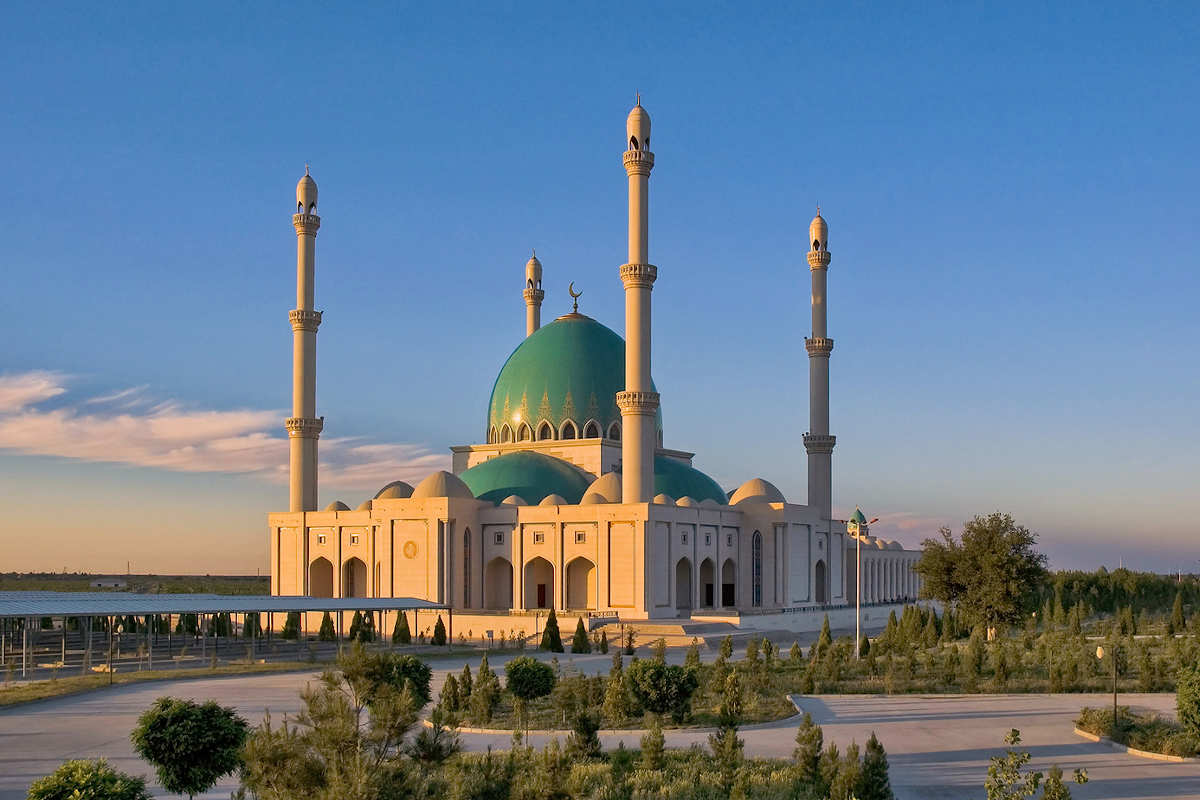Ashgabat - Geok Tepe
 Geok Tepe is 40 km west of Ashgabat. The famous Battle of Geok Tepe took place on the territory of the fortress. The fortress was captured under the command of the Russian general Mikhail Dmitrievich Skobelev.
Geok Tepe is 40 km west of Ashgabat. The famous Battle of Geok Tepe took place on the territory of the fortress. The fortress was captured under the command of the Russian general Mikhail Dmitrievich Skobelev.
Nurberdi Khan and his son Makhtumkuli Khan were at the head of the Turkmen. Today, one of the most beautiful mosques has been built on the site of the fortress and a museum dedicated to the bloody battle of Geok Tepe has been opened.
As you approach the town, several kilometres away, you can see the slender, 60-metre-high minarets and the turquoise, 40-metre-high dome of the Geok Tepe Mosque. Geok Tepe Fortress was built in 1869 40 km west of Ashgabat.
Geok Tepe Fortress is a remarkable site that played a significant role in the history of Turkmenistan. It was the last fortress to stand in the way of Tsarist Russia’s conquest of Central Asia.
The fortress was built by the Russians on the coast of the Caspian Sea as a base for the advance of their troops into Central Asia. Despite the desperate attempts of the Tekin (locals) to hold the fortress, the Russians attacked in August 1879 and captured the fortress after several days of artillery fire.
The Battle of Geok Tepe was fought with completely unequal forces. A network of thousands of regular army soldiers with dozens of rifles faced numerous but poorly armed Tekke troops.
Only 30% of them possessed firearms, mainly flintlocks, while the rest were armed with sabres, pitchforks and sheep shears. There was only one ancient cannon in the entire fortress. During one of the night attacks, the Teke managed to capture an artillery piece, but they could not use it because there were no men to operate it.
In the face of this unequal balance of power, the Teke commandos managed to maintain the siege for more than 20 days, repeatedly making daring night sorties and inflicting tangible damage on the enemy. Even the Tsarist officers recognised the high military spirit and heroism of the Teke men.
The number of dead among the besieged varies widely. Some sources put the figure at 30,000 people, but one accepted estimate is that about 12,000 to 15,000 defenders and civilians perished.
Due to the mistaken accumulation inside the fortress, there were heavy civilian casualties. Emboldened by the success of 1879, the Tekkeners leaned on the ramparts and were unfamiliar with the effectiveness of artillery and the various methods of warfare.
An underground mine laid on the walls of the ramparts, the explosion of which initiated the attack, caused almost half of the entire population of Akhalteke Oasis to gather in the fort and become unwilling victims of the constant bombardment and all the horror of storming the fort on 12 January.
During several hours of bloody fighting in the attack on 12 January, only a fraction managed to escape into the sand. The Tekinians had resisted heroically to the bitter end, knowing that there was no chance of victory.
The Russians tried several times to capture the Geok Tepe, but finally the fortress was taken in December 1880. The Russians returned to the Geok Tepe, dug an underground tunnel into the fortress, blew up the entrance gate and captured the fortress.
After the conquest of Geok Tepe on 18 January 1881, the Russians marched to Ashgabat and established an East Caspian region that included regions such as Mangyshlak, Kizij, Ashgabat, Tejen and Merv.
Today, Geok Tepe Fortress is one of the country’s historical and architectural monuments. It towers over the Caspian Sea and commemorates a memorable battle that changed the course of history for more than one nation.
